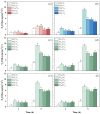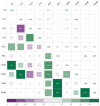Microbial Community Imbalance Drives Nitrous Oxide Emissions from Strongly Acidic Soil-Insights from a Laboratory Experiment with Microbial Inhibitors
- PMID: 40563872
- PMCID: PMC12189618
- DOI: 10.3390/biology14060621
Microbial Community Imbalance Drives Nitrous Oxide Emissions from Strongly Acidic Soil-Insights from a Laboratory Experiment with Microbial Inhibitors
Abstract
Nitrous oxide (N2O) is a potent greenhouse gas with intensive emissions from acidic soil. This study explored the impact of the disruption of the microbial balance from microbial inhibitors (streptomycin and cycloheximide) on soil's N2O emission and nitrogen (N) dynamics. Under all the conditions examined, biotic processes accounted for 96-98% of total N2O emissions. High concentrations of streptomycin (6 and 10 mg g-1) reduced N2O emissions from 2.24 μg kg-1 h-1 to 1.93 μg kg-1 h-1 and 2.12 μg kg-1 h-1, respectively, whereas lower concentrations (2 and 4.5 mg g-1) increased emissions from 2.24 μg kg-1 h-1 to 2.95 μg kg-1 h-1 and 3.27 μg kg-1 h-1, respectively. Lower cycloheximide (2 and 4.5 mg g-1) significantly enhanced N2O emissions, reaching 9.15 μg kg-1 h-1 and 5.68 μg kg-1 h-1, respectively, whereas higher dosages (6 mg g-1 and 10 mg g-1) inhibited N2O emissions, reducing them to 5.55 μg kg-1 h-1 and 4.84 μg kg-1 h-1, respectively. Carbon dioxide (CO2) emissions generally decreased with increasing inhibitor dosages but significantly increased at 2 mg g-1 and 4.5 mg g-1 streptomycin. The inhibitors also altered soil N and carbon (C) dynamics, increasing ammonium (NH4+-N), dissolved organic nitrogen (DON), and dissolved organic carbon (DOC) levels. Pearson correlation analysis indicated that N2O emission was negatively correlated with cycloheximide dosage (R = -0.68, p < 0.001), NH4+-N (R = -0.31, p < 0.001) and DOC content (R = -0.57, p < 0.05). These findings highlight the consequences of microbial disruption on N2O emission and the complex microbial interactions in acidic soils. High concentrations of microbial inhibitors effectively reduce N2O emissions by suppressing key microbial groups in nitrification and denitrification. Conversely, lower concentrations may prompt compensatory responses from surviving microorganisms, resulting in increased N2O production. Future research should focus on sustainable management strategies to mitigate N2O emissions while preserving the soil's microbial community.
Keywords: acidic soil; dissolved organic carbon; microbial inhibition; nitrogen dynamics; nitrous oxide.
Conflict of interest statement
The authors declare no conflicts of interest.
Figures






References
-
- Tokuda S., Hayatsu M. Nitrous oxide production from strongly acid tea field soils. Soil Sci. Plant Nutr. 2000;46:835–844. doi: 10.1080/00380768.2000.10409149. - DOI
Grants and funding
LinkOut - more resources
Full Text Sources

